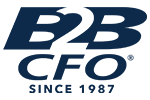
Financial Vigilance: The Business Owner’s Guide to Preventing Embezzlement
Posted on April 15, 2024 by B2B CFO
Embezzlement is a serious financial crime that occurs when a trusted individual within a business unlawfully misappropriates funds or assets for personal gain. This betrayal of trust not only results in financial losses for the company but also inflicts a deeper wound by breaching the faith placed in the perpetrator. Safeguarding against embezzlement requires robust internal controls and vigilant oversight to protect the integrity and financial well-being of your business.
As business owners, we never suspect that a trusted employee would steal from us—whether it is inventory, office equipment, or cash. But imagine the devastation that hits when you realize your trust was violated by a key employee who had slowly siphoned thousands of dollars out of your much-needed cash flow, ripping through the firm’s finances.
Fraud, theft, and embezzlement are real threats facing every business in America. Employee theft is on the rise. These stats reveal the painful reality of workplace theft:
- 55% of perpetrators are managers
- 20% of employees are aware of theft in their companies
- 18 months is the average time to catch fraud
- 7% of businesses lose their annual revenue to theft or fraud
- 44% of employees say their companies need stronger fraud prevention controls
Incidents of fraud cost us time, money, and even our reputation. What assessments and actions should companies take to protect from potential losses? For businesses of all kinds, employee theft is a constant threat. But you can mitigate your risk by educating yourself and taking important preventative measures.
The first step is awareness of common red flags linked to workplace embezzlement:
- Unexplained inventory shortages
- Discrepancies in sales and shipping documents
- Employee refusal to take vacation time
- Incomplete or false customer information
- Missing receipts or unexplained invoices
- Erratic employee behavior or lifestyle changes
- Signing rights, accounting, and bank deposits delegated to only one employee
Organizations with a mission to prevent embezzlement to the best of their ability need a comprehensive process of internal controls and a hiring and screening process to curtail theft before it starts. Creating internal controls with these steps can help you prevent workplace theft so you can focus on growing a profitable business.
In today’s business environment, protecting your company from embezzlement is paramount. Implementing robust internal controls, conducting regular audits, and promoting a culture of transparency and accountability are just a few key steps to safeguard your company from financial misconduct. Here are some critical steps you can take to help:
Segregate Accounting Duties
Your business should have at least two trusted employees responsible for the cash handling and accounting functions interchangeably. Cross-training is an effective method of stopping theft. It prevents one employee from performing any single accounting transaction for any length of time.
Restrict Access to Assets
A common mistake made by countless business owners is a failure to safeguard information and property. Limiting your employees’ access to your network and/or specific files based on the time of day or their job position can deter theft. Be sure to change passwords frequently.
Invest in Inventory Tracking Software
Inventory tracking software is used for everything from retail stores to government organizations. The ability to track products in real time allows you to know exactly what is in stock, what has been sold, or even damaged. If inventory counts are amiss, they can be tracked quickly and unveil any fraudulent activity.
Know Your Employees
Never hire in haste. Review your hiring discovery process. Ensure your existing screening tools dig into critical factors that are vital to understanding what a candidate is really like. Before offering a position, require reference checks, criminal background and credit checks, and even drug testing. Remember to carefully screen contractors and use reputable vendors. With existing employees, as their level of interaction with finances increases, so too should the levels of security and segregation of duties.
Audit the Books Regularly
Businesses should routinely audit areas that deal in cash, refunds, product returns, inventory management, and accounting functions. Monitor receivables and payables. Investigate discrepancies, reconcile your company’s accounts at least monthly, and examine anything that doesn’t balance. Compare checks to the company cash disbursements journal and make certain that payees on checks match the payees shown in the journal.
Train Employees to Prevent Fraud
Employees in fraud-prone areas of the business should know the warning signs of fraud, implement prevention skills, and know how to report suspicious behavior by coworkers and even customers. Make it easy for employees to report their suspicions by setting up an anonymous tip line.
Protect Credit Card Information
Separate business and personal accounts as it will help with tracking expenses much easier. Be on guard as to whom you provide your credit card information to, and use secure, online bill payment services when possible.
Get Expert Help
If you suspect fraud and embezzlement, assess your current process and ramp up your internal controls. Run an investigation to determine the source of the fraud and then calculate the financial damage. Business owners need to tread carefully since false accusations can lead to lawsuits. Always involve your attorney, CFO, and insurance agent for advice.
Has your organization fallen victim to employee fraud? Are you unsure if you have strong enough controls in place? B2B CFO® can help if you suspect fraud or want to create strong internal controls to create anti-embezzlement procedures in your workplace. Working with thousands of businesses of different industries and complexities, we can help you devise internal controls that safeguard your business. For a complimentary discussion and consultation, email me at ArtBottoms@b2bcfo.com.


